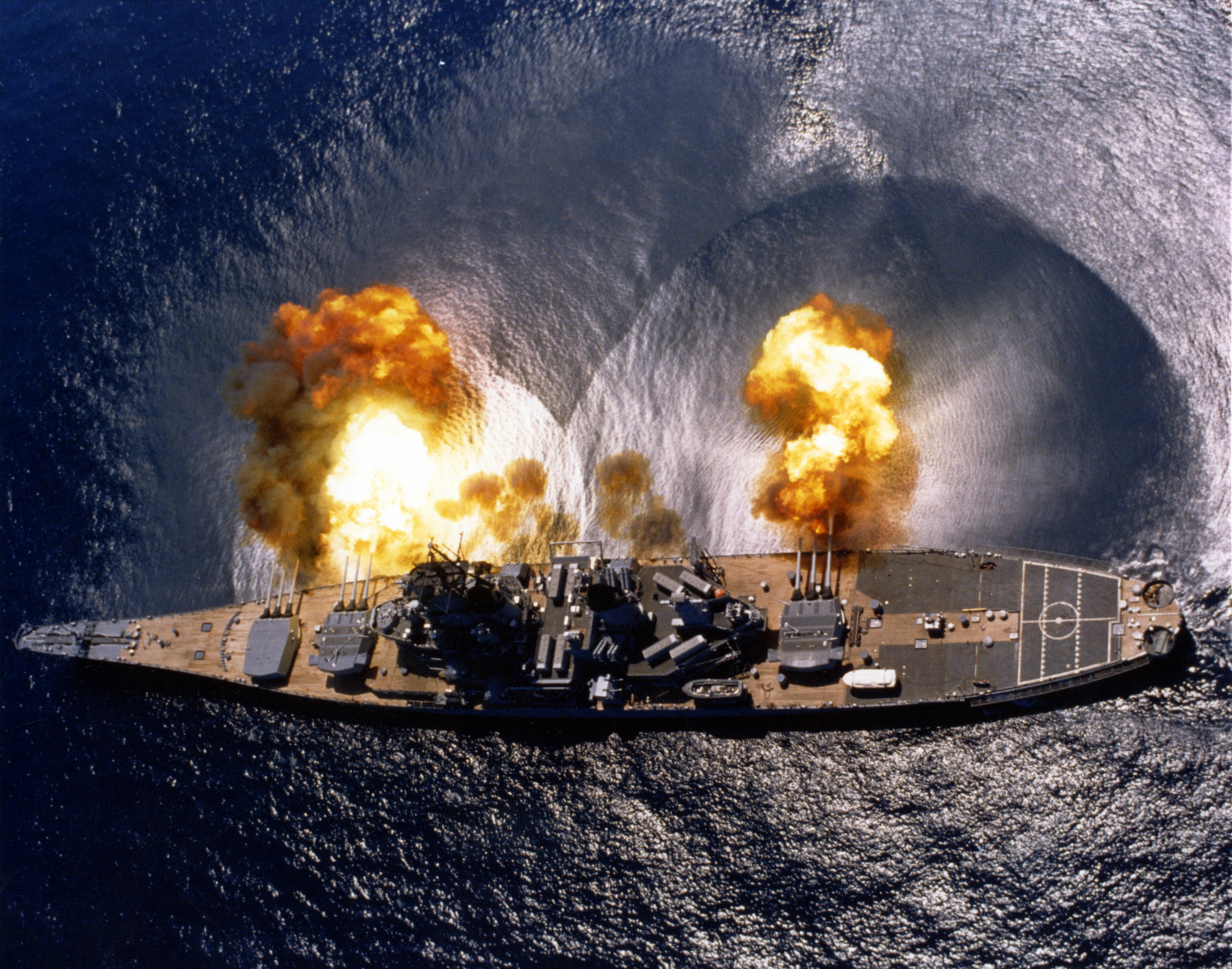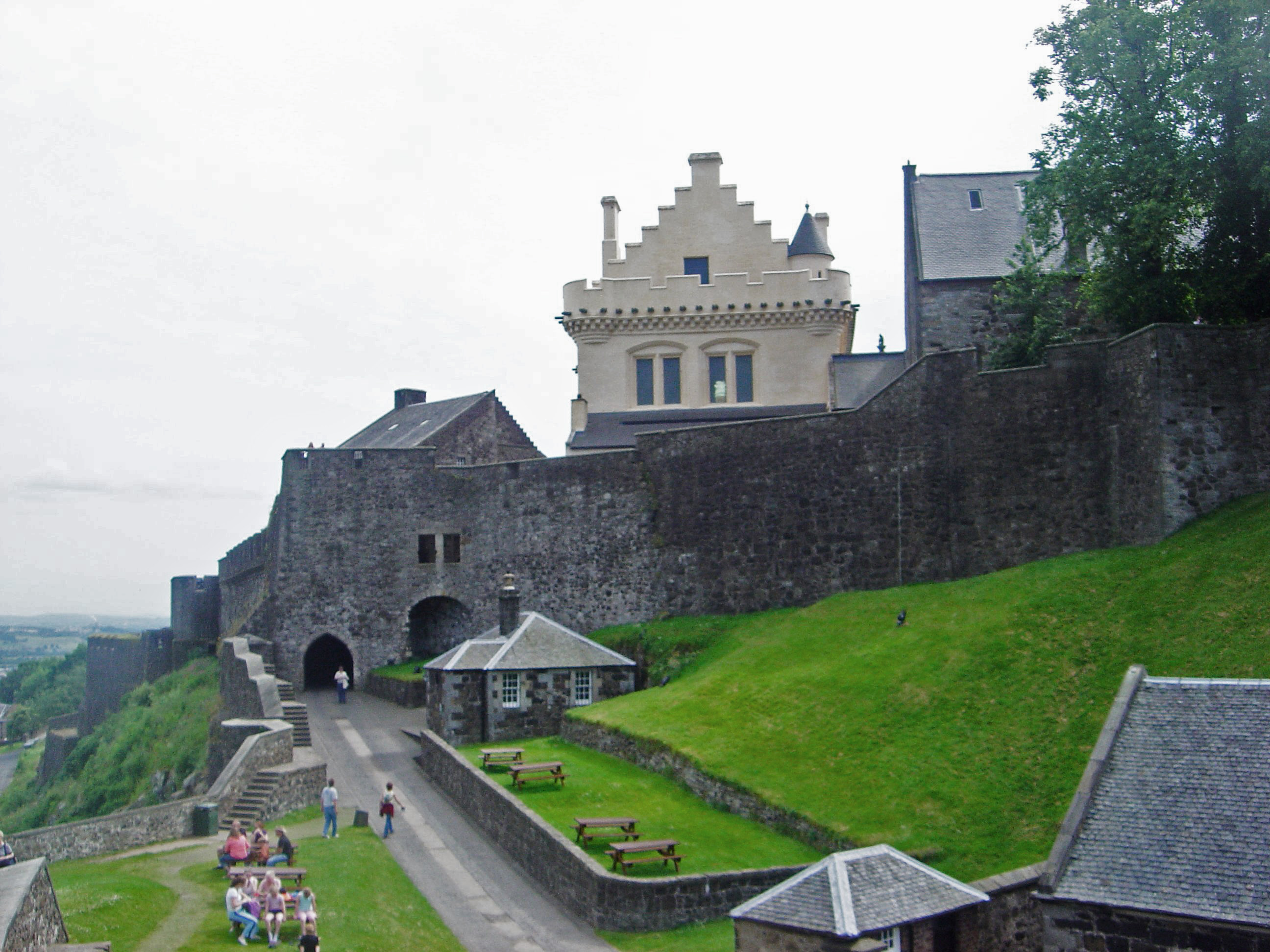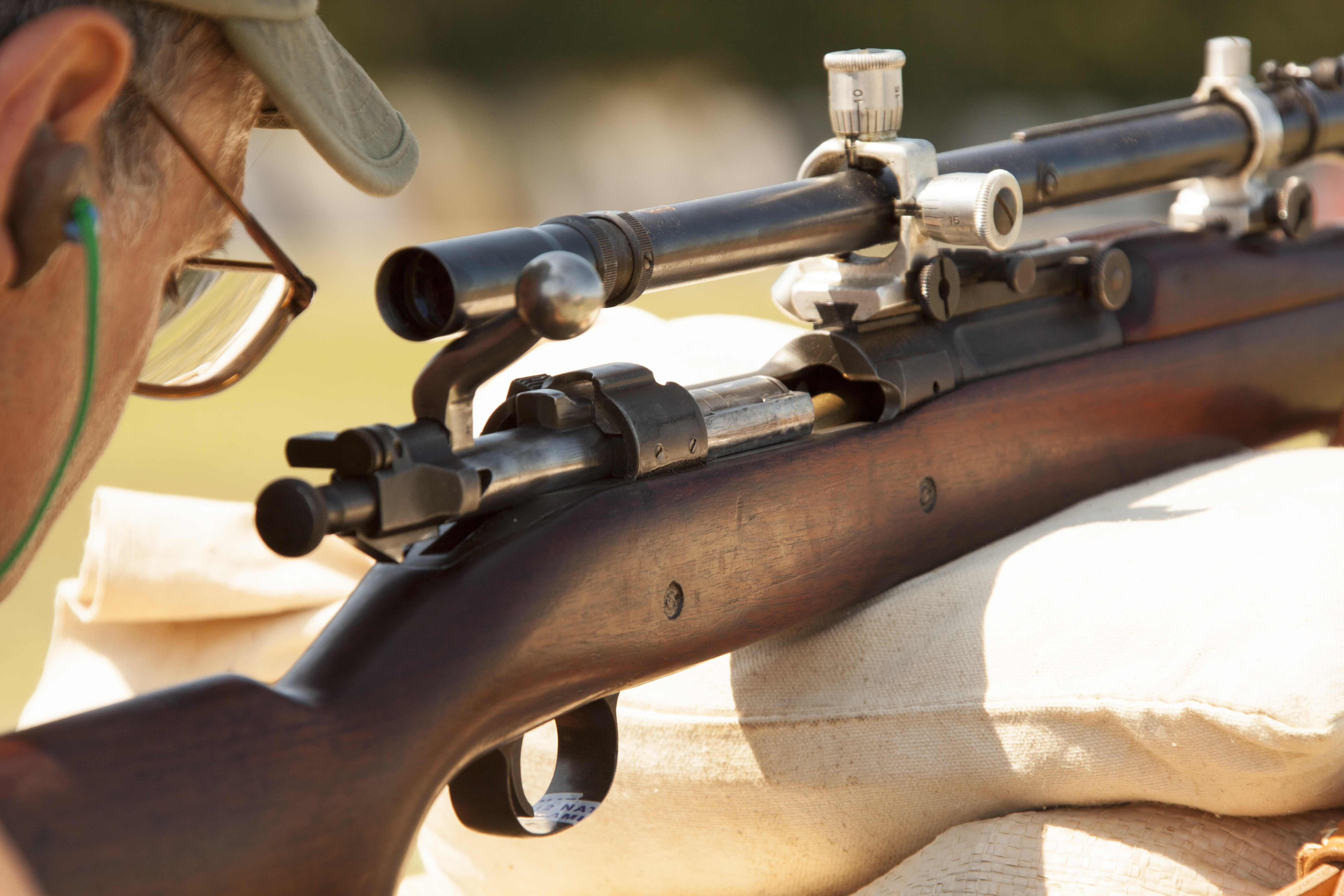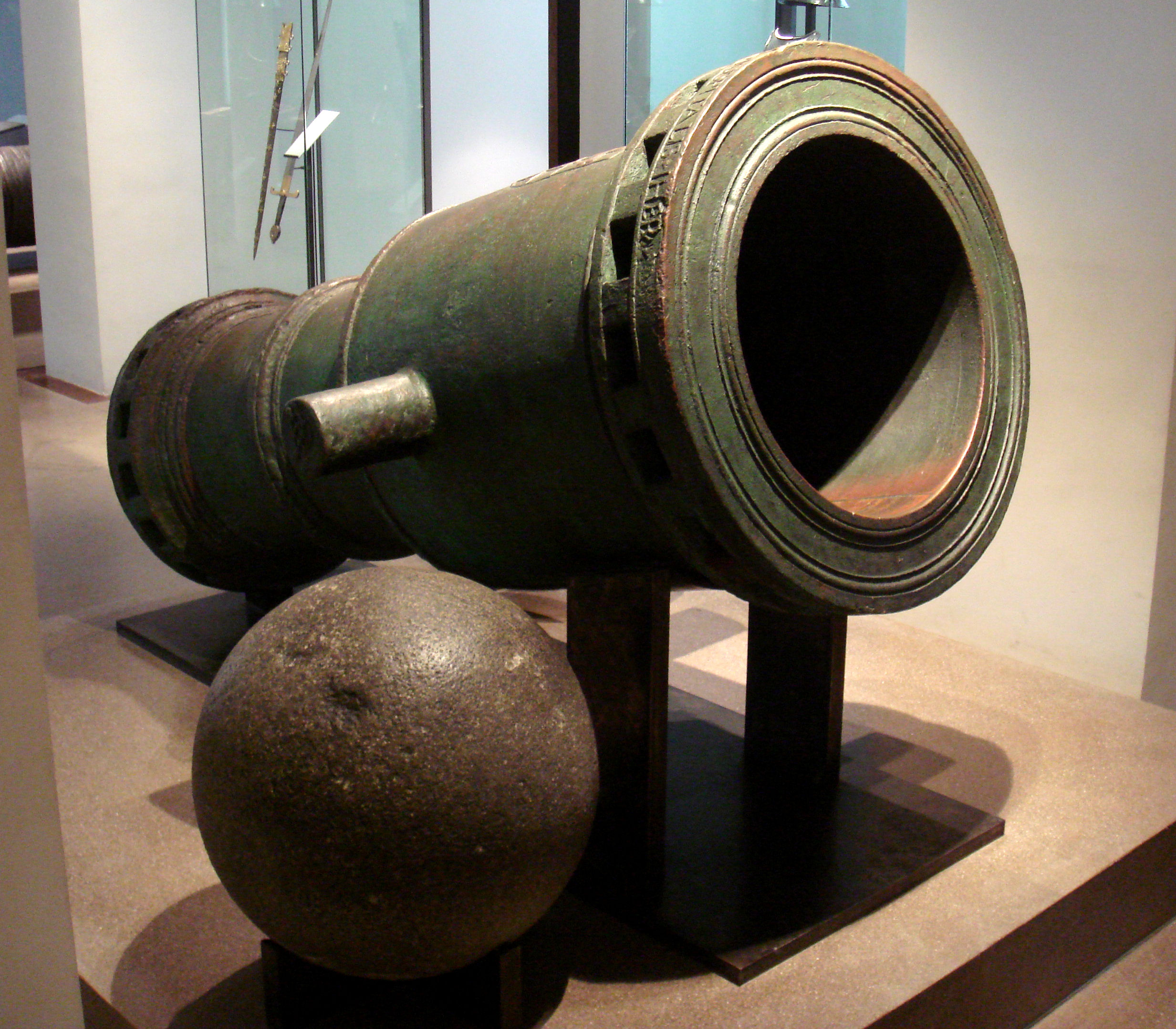|
Culverin
A culverin was initially an ancestor of the hand-held arquebus, but the term was later used to describe a type of medieval and Renaissance cannon. The word is derived from the antiquated "culuering" and the French (from " grass snake", following ). From its origin as a hand-held weapon it was adapted for use as artillery by the French in the 15th century and for naval use by the English in the 16th century. The culverin as an artillery piece had a long smoothbore gun barrel with a relatively long range and flat trajectory, using solid round shot projectiles with high muzzle velocity. Hand culverins The hand culverin consisted of a simple smoothbore metal tube, closed at one end except for a small touch hole designed to allow ignition of the gunpowder. The tube was attached to a wood or metal extension which could be held under the arm. It was loaded with gunpowder and lead bullets and fired by inserting a burning slow match into the touch hole. James IV of Scotland ... [...More Info...] [...Related Items...] OR: [Wikipedia] [Google] [Baidu] |
Cannon
A cannon is a large-caliber gun classified as a type of artillery, which usually launches a projectile using explosive chemical propellant. Gunpowder ("black powder") was the primary propellant before the invention of smokeless powder during the late 19th century. Cannons vary in gauge (firearms), gauge, effective range, mobility (military), mobility, rate of fire, elevation (ballistics), angle of fire and firepower; different forms of cannon combine and balance these attributes in varying degrees, depending on their intended use on the battlefield. A cannon is a type of heavy artillery weapon. The word ''cannon'' is derived from several languages, in which the original definition can usually be translated as ''tube'', ''cane'', or ''reed''. The earliest known depiction of cannons may have appeared in Science and technology of the Song dynasty#Gunpowder warfare, Song dynasty China as early as the 12th century; however, solid archaeological and documentary evidence of cannons do ... [...More Info...] [...Related Items...] OR: [Wikipedia] [Google] [Baidu] |
Naval Artillery
Naval artillery is artillery mounted on a warship, originally used only for naval warfare and then subsequently used for more specialized roles in surface warfare such as naval gunfire support (NGFS) and anti-aircraft warfare (AAW) engagements. The term generally refers to powder-launched projectile-firing weapons and excludes self-propelled projectiles such as torpedoes, rockets, and missiles and those simply dropped overboard such as depth charges and naval mines. Origins The idea of ship-borne artillery dates back to the classical era. Julius Caesar wrote about the Roman navy's usage of ship-borne catapults against Celtic Britons ashore in his ''Commentarii de Bello Gallico''. The dromons of the Byzantine Empire carried catapults and Greek fire. From the Middle Ages onwards, warships began to carry cannons of various calibres. In the Battle of Tangdao in 1161, the Southern Song general Li Bao used huopao (a type of gunpowder weapons, possibly cannons) and fire arro ... [...More Info...] [...Related Items...] OR: [Wikipedia] [Google] [Baidu] |
James IV Of Scotland
James IV (17 March 1473 – 9 September 1513) was List of Scottish monarchs, King of Scotland from 11 June 1488 until his death at the Battle of Flodden in 1513. He inherited the throne at the age of fifteen on the death of his father, James III of Scotland, James III, at the Battle of Sauchieburn, following a rebellion in which the younger James was the figurehead of the rebels. James IV is generally regarded as the most successful of the House of Stuart, Stewart monarchs of Scotland. He was responsible for a major expansion of the Royal Scots Navy, Scottish royal navy, which included the founding of two royal dockyards and the acquisition or construction of 38 ships, including the ''Great Michael'', the largest warship of its time. James was a patron of the arts and took an active interest in the law, literature and science. With his patronage the Chepman and Myllar Press, printing press came to Kingdom of Scotland, Scotland, the University of Aberdeen and the Royal College o ... [...More Info...] [...Related Items...] OR: [Wikipedia] [Google] [Baidu] |
Demi-cannon
The demi-cannon was a medium-sized cannon, similar to but slightly larger than a culverin and smaller than a regular cannon, developed in the early 17th century. A full cannon fired a 42-pound shot, but these were discontinued in the 18th century as they were seen as too unwieldy. The lower tiers of 18th century English warships were usually equipped with demi-cannons. Ships featuring demi-cannons included ''Sovereign of the Seas'', ''Resolution'' and ''James'', which fought in the Anglo-Dutch naval wars. Demi-cannons were also used on HMS ''Stirling Castle'', the wreck of which was discovered in the Goodwin Sands. Several examples of this weapon were recovered from the site. The barrels of demi-cannon were typically long, had a calibre of and could weigh up to . It required of black powder to fire a round shot. The demi-cannon had an effective range of . These 32-pounders were used during the 18th century on first-rate ships of the line A ship of the line was a t ... [...More Info...] [...Related Items...] OR: [Wikipedia] [Google] [Baidu] |
Falkland Palace
Falkland Palace, in Falkland, Fife, Scotland, is a royal palace of the Scottish kings. It was one of the favourite places of Mary, Queen of Scots, who took refuge there from political and religious turmoil of her times. Today it is under the stewardship of Ninian Stuart, who delegates most of his duties to the National Trust for Scotland. The Chapel Royal in the Palace is dedicated to Thomas the Apostle. It is open to the public and reserved for Catholic worship. History Early years In the late 12th century, a royal hunting lodge was located on this site. The lodge was expanded in the 13th century to operate as a castle, owned by the Earls of Fife of the noted Clan MacDuff. The castle was built here because the site is on a slight hill that could be defended. The surrounding land eventually were developed as the Palace gardens. To the north, between the royal stable and the River Eden, was a great oak wood. Its many groves merged into the surrounding parkland. Timb ... [...More Info...] [...Related Items...] OR: [Wikipedia] [Google] [Baidu] |
16th Century
The 16th century began with the Julian calendar, Julian year 1501 (represented by the Roman numerals MDI) and ended with either the Julian or the Gregorian calendar, Gregorian year 1600 (MDC), depending on the reckoning used (the Gregorian calendar introduced a lapse of 10 days in October 1582). The Renaissance in Italy and Europe saw the emergence of important artists, authors and scientists, and led to the foundation of important subjects which include accounting and political science. Copernicus proposed the Copernican heliocentrism, heliocentric universe, which was met with strong resistance, and Tycho Brahe refuted the theory of celestial spheres through observational measurement of the SN 1572, 1572 appearance of a Milky Way supernova. These events directly challenged the long-held notion of an immutable universe supported by Ptolemy and Aristotle, and led to major revolutions in astronomy and science. Galileo Galilei became a champion of the new sciences, invented the first ... [...More Info...] [...Related Items...] OR: [Wikipedia] [Google] [Baidu] |
Breech-loading Swivel Gun
A breech-loading swivel gun was a particular type of swivel gun and a small breech-loading cannon invented in the 14th century. It was equipped with a swivel for easy rotation and was loaded by inserting a mug-shaped device called a chamber or breech block, filled with gunpowder and projectiles. It had a high rate of fire, as several chambers could be prepared in advance and quickly fired in succession and was especially effective in anti-personnel roles. It was used for centuries by many countries of Europe, Asia and Africa. Characteristics Although breech-loading is often considered a modern innovation which facilitated the loading of cannons,Turnbull, p. 105 breech-loading swivel guns were invented in the 14th century, and used worldwide from the 16th century onward by numerous countries, many of them non-European. They have been called by many names, sometimes "Murderer", "Base", "Sling", "Port-Piece", "Serpentine", "Culverin", "Pierrier", "Stock Fowler", and "Patterero" ... [...More Info...] [...Related Items...] OR: [Wikipedia] [Google] [Baidu] |
Swivel
A swivel is a connection that allows the connected object, such as a swivel gun, gun, swivel chair, chair, Caster, swivel caster, or an anchor rode to rotate horizontally or vertically. Swivel designs A common design for a swivel is a cylindrical rod that can turn freely within a support structure. The rod is usually prevented from slipping out by a nut, washer or thickening of the rod. The device can be attached to the ends of the rod or the center. Another common design is a sphere that is able to rotate within a support structure. The device is attached to the sphere. A third design is a hollow cylindrical rod that has a rod that is slightly smaller than its inside diameter inside of it. They are prevented from coming apart by flanges. The device may be attached to either end. A swivel joint for a pipe (material), pipe is often a screw thread, threaded connection in between which at least one of the pipes is curved, often at an angle of 45 or 90 degrees. The connection is t ... [...More Info...] [...Related Items...] OR: [Wikipedia] [Google] [Baidu] |
Chamber (firearms)
The chamber of a firearm is the cavity at the back end of a breechloading weapon's barrel or cylinder, where the ammunition is inserted before being fired. The rear opening of the chamber is the breech, and is sealed by the breechblock or the bolt. Function The act of ''chambering'' a cartridge means the insertion of a round into the chamber, either manually or through the action of the weapon, e.g., pump-action, lever-action, bolt action, or autoloading operation generally in anticipation of firing the weapon, without need to "load" the weapon upon decision to use it (reducing the number of ''actions'' needed to discharge). Automatic and single-shot pistols (such as Derringers), rifles, and shotguns generally have a single chamber integral to their barrels, but revolvers have multiple chambers in their cylinder, and no chamber in their barrel. Thus, pistols, rifles, and shotguns can usually still be fired with the magazine removed as long as a cartridge is inser ... [...More Info...] [...Related Items...] OR: [Wikipedia] [Google] [Baidu] |
Naval Boarding
Naval boarding is an offensive (military), offensive military tactics, tactic used in naval warfare to come up against (or alongside) an enemy watercraft and attack by inserting combatants aboard that vessel. The goal of boarding is to invade and overrun the enemy personnel on board in order to capture, sabotage, or destroy the enemy vessel. While boarding attacks were originally carried out by ordinary sailors who are proficient in hand-to-hand combat, larger warships often deploy specially trained and equipped regular troops such as marines and special forces as boarders. Boarding and close-quarters combat had been a primary means to conclude a naval battle since ancient history, antiquity, until the early modern period when heavy naval artillery gained tactical primacy at sea. A cutting out boarding is an attack by small boats, preferably at night and against an unsuspecting and anchored, target. It became popular in the later 18th century, and was extensively used during ... [...More Info...] [...Related Items...] OR: [Wikipedia] [Google] [Baidu] |
Bombard (weapon)
The bombard is a type of cannon or mortar which was used throughout the Late Middle Ages and the early modern period. Bombards were mainly large calibre, muzzle-loading artillery pieces used during sieges to shoot round stone projectiles at the walls of enemy fortifications, enabling troops to break in. Most bombards were made of iron and used gunpowder to launch the projectiles. There are many examples of bombards, including Mons Meg, the Basilic, the Dardanelles Gun, and the handheld bombard. The weapon provided the name to the Royal Artillery rank of bombardier and the word 'bombardment'. Terminology The term "bombard" was first used to describe guns of any kind from the early to mid-14th century, but it was later applied primarily to large cannons during the 14th to 15th centuries. Despite its strong association with large cannons, there is no standard size for bombards, and the term has been applied to cannons only a meter in length as well as cannons several meters ... [...More Info...] [...Related Items...] OR: [Wikipedia] [Google] [Baidu] |
Breechloader
A breechloader is a firearm in which the user loads the ammunition from the breech end of the barrel (i.e., from the rearward, open end of the gun's barrel), as opposed to a muzzleloader, in which the user loads the ammunition from the ( muzzle) end of the barrel. The vast majority of modern firearms are generally breech-loaders, while firearms made before the mid-19th century were mostly smoothbore muzzle-loaders. Only a few muzzleloading weapons, such as mortars, rifle grenades, some rocket launchers, such as the Panzerfaust 3 and RPG-7, and the GP series grenade launchers, have remained in common usage in modern military conflicts. However, referring to a weapon explicitly as breech-loading is mostly limited to weapons where the operator loads ammunition by hand (and not by operating a mechanism such as a bolt-action), such as artillery pieces or break-action small arms. Breech-loading provides the advantage of reduced reloading time because it is far quicker to loa ... [...More Info...] [...Related Items...] OR: [Wikipedia] [Google] [Baidu] |









